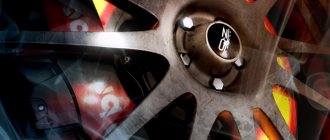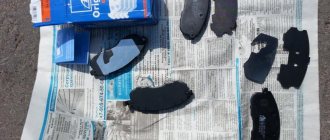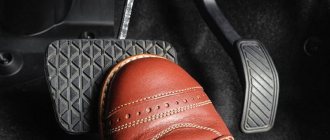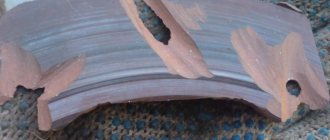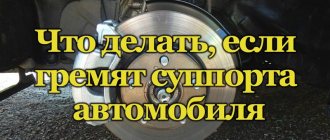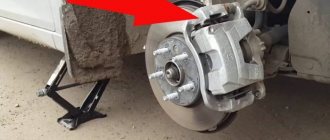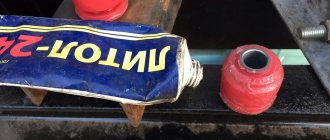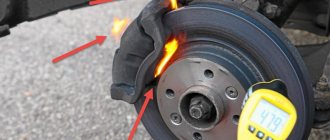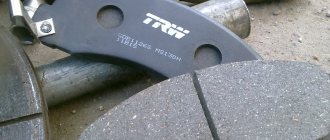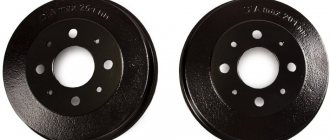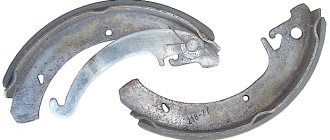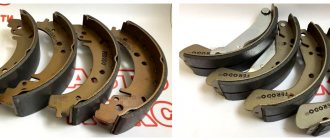The process of braking a car is based on the force of friction and cannot but be accompanied by the release of heat. The brakes constantly heat up and cool down. On modern cars, brake discs can be installed not only on the front, but also on the rear axles. Disc brakes are more efficient than drum brakes, easier to maintain and more reliable.
The principle of operation of such a brake is the pressure of the piston (6) on one of the brake pads (4), which begins to rub against the disc. The second block presses on it automatically by the caliper body, which moves along the guides (10). The pads on both sides begin to compress the disc - as a result, the rotation of the wheels slows down.
Of course, heat is generated. The temperature of disc brakes during intensive driving reaches 250-300°C. For sports cars, they are made of ceramics that can withstand heat up to 1000°C without deformation. But they do not go on mass sale due to their high cost.
Do the drums get warm? Exploring other problems
Often the problem of hot drums is hidden in other parts. You can do a little experiment. Raise the back side of your car where the brake heats up on a jack. Next, spin the wheel and listen for any sounds. If there are shuffling sounds, the problem is related to the pads that are not aligned and are shuffling on the drum. This is why it heats up. But if the wheel rotates more or less well, the problem may be related to other parts of the car.
Heating can cause a number of other incidents:
- failure of the brake cylinders. in this case, one part of the block will be constantly pressed against the drum, but during movement this will also be recorded by the constant squeaking of the wheel;
- jammed hub. if during assembly the master made a number of unpleasant mistakes, the device on which the wheel rests may heat up, this is a rather unpleasant and dangerous symptom;
- heating of wheel bearings. in this case, heating occurs due to the lack of temperature play, the device heats up from too much load and will quickly fail;
- The rubber heats up due to excessively low pressure and heavy load. heating the rubber can quickly warm the wheel itself, as well as all the elements associated with it;
- the wheel rim heats up due to friction with certain parts, this can be investigated by simply raising the car on a jack and rotating it, the wheel should rotate freely and without problems.
As you can see, a whole range of situations are possible that lead to heating of the rear wheel in general and the drum in particular. Therefore, we can safely say that in this case it is impossible to do without high-quality diagnostics. You can also give advice to those who are going to carry out repair work on the rear brake of a car. It is better to buy high-quality spare parts that will not let you down in a difficult situation and will not cause serious problems. A lot depends on the details; their incorrect size will lead to complex consequences.
We suggest watching a video about heating the rear brake drum:
Related Posts
What is the length of the wiper blades on the MAZ 5440?
- Author: Roman Shevchuk
- 07 March 03:29
Guys, good afternoon everyone! Please tell me. the length of the brushes (wipers) on the MAZ 5440, otherwise I went to buy it and forgot to measure it. And by the way, I didn’t look straight or under the hook. MACHINE 2022
Is there a valve on the cooler?
- Author: Dmitry Ivanov
- 07 March 02:21
Hi all. On the Eureka there is a plug on the bottom of the cooler on one side, on the other there is air flowing at idle. Why didn’t anyone look into it? Maybe some kind of valve or something. I can’t look at it myself now - the dirt is flowing off the car)))
Tell me, is the MAZ 5432 door lock cylinder replaced or with the handle only?
- Author: Igor Elivanov
- 07 March 01:01
Tell me, is the MAZ 5432 door lock cylinder replaced or with the handle only?
How to convert it back to a flag, gearbox 238?
- Author: Nikolay Lipovsky
- 06 March 12:55
Guys, tell me how to convert it back to the flag, gearbox 238 is short, right now in the cabin there is a button on the gearbox, there are 2 electric valves, and with this it switches the lower upper row, I want to do it in a native way from the flag, how to check this tap on the gearbox, when buying, the seller said that that’s how it was originally when he bought it and doesn’t know how to change it back
Handbrake cable. the eternal problem of drums
The rear brake performs not only dynamic braking functions. He also plays the role of a handbrake. Separate cable systems are responsible for this, which tighten the pads and release them when the handbrake is released. In this case, the system does not depend on the brake fluid and is driven mechanically by raising the handbrake lever in the cabin. The cables themselves tend to rust and jam, and they can also move poorly through grooves and holes, creating problems for the car owner.
- select a section of the road where there is a very slight slope, do not turn off the car, release the brake pedal and do not touch the handbrake, record how fast the car rolls;
- then stand in the same place and fully tighten the handbrake, check whether the car is not rolling in this position, it should stand confidently and without the slightest attempt to move down the hill;
- then release the brake pedal, sharply release the handbrake completely and see how the car behaves, in this case you can see how quickly the pads close;
- if the car first stood still and then began to move with a grinding noise, there is a problem in the pad reduction mechanism, which must be repaired for normal driving;
- If the car is left standing still, then the culprit for heating the drum while driving is most likely jammed handbrake cables; they need to be replaced along with all fasteners.
READ Replacing Brake Discs Lada Kalina
When replacing the handbrake cables, do not forget to change the two working and central cables. The system will be different in each car, but in general the equipment will be similar. Again, you shouldn’t change the cables yourself. This can lead to unpredictable consequences. You can independently repair parts of the braking system if you have sufficient experience and can efficiently assemble the equipment without referring to various reference books and manuals.
Grinding in new pads. The disks are heating up.
The drums get warm after replacing everything.
The drums get warm after replacing everything.
Post by IgorTe » April 21, 2014, 10:33 pm
Re: Drums get warm after replacing everything.
Post by torf » April 22, 2014, 10:10 pm
Re: Drums get warm after replacing everything.
Post by IgorTe » April 23, 2014, 21:18
Re: Drums get warm after replacing everything.
Post by Angela » April 24, 2014, 3:20 pm
Re: Drums get warm after replacing everything.
Post by IgorTe » Apr 24, 2014, 3:54 pm
Re: Drums get warm after replacing everything.
Post by torf » April 24, 2014, 11:11 pm
Post by boatman » Jun 22, 2015, 10:11 am
Post by Dimon » June 22, 2015, 10:39 am
Post by Viktor Viktorovich » June 22, 2015, 5:09 pm
Post by Eugeniy » June 22, 2015, 5:17 pm
Post by Bonya » 01 Jun 2022, 19:51
Post by denzas » 01 Jun 2022, 20:37
Post by matphey » 01 Jun 2022, 21:05
Post by Vladimir1959 » 01 Jun 2022, 21:16
Post by Bonya » June 02, 2022, 09:10
The primer says that you need to measure the inside. of the drum and shoes in the assembled state and adjust so that the shoe diameter is 1.5-2 mm smaller than the drum (it seems so). The thing is that I make it so that the drum is put on very easily, the handbrake almost does not hold this wheel, and when I drive, the drum is removed with effort, prying it with a screwdriver in a circle and when removing the pads, they unclench a little more and the drum is tensioned with a little effort.
I was changing the right cable (while the car was moving), when I unscrewed the equalizer nut and took out the right cable, the left one fell out of the equalizer itself. When I inserted the cable bosses into the leveler bar, I didn’t pay attention, but when I pulled it on, I saw that the bar was strictly perpendicular to the car. I looked at the alignment of the nut and the bend of the equalizer in relation to the thread—it seemed correct. I didn't find anything in the primer about equalizer skew. Maybe it's worth trying to turn the equalizer the other way? Thank you.
Source
Incorrect installation of components or poor quality parts
It is quite possible that excessive heating of the brakes is due to the fact that the equipment was assembled incorrectly at the service center. In this case, you will have to completely disassemble the system and check the quality of its assembly. And this must be done as soon as possible. In the best case, you will be able to reassemble everything correctly and just drive the car without any problems. In the worst situation, you will have to disassemble and reassemble the device several times to find the real problem.
- an incorrectly assembled mechanism does not return the pads back, so that when the brake pedal is pressed, the pads remain in the spread position and continue to slow down for some time;
- a dropped or not put on spring for adjusting the brake pads gives a similar effect; the elements are brought together only if you sharply release the brake pedal, and the adjustment will be incomplete;
- purchased low-quality spare parts can cause such problems. the parts may be too large; a 1-2 mm misalignment in size is enough to cause constant friction;
- a thick lining can also cause strong heating, in this case you purchased defective pads, they should be replaced, and not modified or sawed off their parts;
- Perhaps one of the parts of the brake mechanism has failed, rusted or become very dirty; this may well cause the unpleasant moments described in the article.
You shouldn’t disassemble the brake drum yourself unless you have experience and sufficient confidence that you can put everything back in place efficiently. It should be borne in mind that the braking process must work very well, so subsequent disassembly and reassembly of the brakes should be entrusted to specialists at a proven station. If you don't have one, it's worth asking other drivers of cars like yours. Perhaps they will suggest you a good service station or even a garage mechanic with golden hands and a low price tag for the job.
Features of the car brake system
The purpose of the brakes is to stop the car as quickly and safely as possible. The easiest way to do this is with the help of friction, which occurs in brake mechanisms.
In modern cars, brakes are located on each wheel in order to make the most efficient use of the traction of the tires with the road.
On the subject: Why do brakes squeak when braking?
The work uses:
- brake discs or drums, metal parts associated with wheel hubs;
- brake pads, consisting of a base and linings made of a material that has a high coefficient of friction against cast iron or steel and can withstand high temperatures with minimal wear of both the pads themselves and the discs (drums);
- brake drive, mechanical, hydraulic and electronic devices that transmit force from the driver's controls to the brake mechanisms.
There are several types of brake systems; the service and parking brakes play a significant role in heating the discs.
Both of them work approximately the same way - the driver, through the drive, creates a mechanical force on the brake pads, which are pressed against the discs or drums. A friction force arises, directed against the inertia of the car, kinetic energy decreases, and speed drops.
What can happen if the drums get too hot?
Let's start with the fact that this unit will wear out a lot. Most likely, at the next red-hot glow, this unit will become deformed and take on the shape of an “oval”. In this situation, further travel by car will be greatly complicated. But this is not the worst option that can be imagined in the operation of transport. You are unlikely to want to experience the emotions that a completely broken drum . It is possible that this situation will lead to loss of control of the vehicle for a variety of reasons.
So, the following problems may arise:
- due to excessive heating of the braking system in the rear, the brake fluid in one of the circuits will begin to boil, this will lead to complete failure of the brakes on two wheels and to real problems with control;
- a breakdown of parts in the brake fluid circulation system may occur, in which case the fluid will simply begin to flow out and sag in the system, the brakes will fail completely;
- the drum may become deformed and begin to rub against the pads during movement, this will cause braking, and sometimes even jamming of the wheel during the trip, which will lead to loss of controllability;
- all the mechanisms inside the drum will be worn out, you, at a minimum, end up with a complete replacement of this unit with all its contents, this is an expensive pleasure, which is better not to resort to;
- the drum can fly apart from the heat, especially if it is not the highest quality part, bought inexpensively at the car market, in which case fatal damage to the rear part of the car’s suspension is possible.
As you can see, the drums are faulty and overheating. This is a real problem for the modern motorist. So, if your rear brakes are overheating, you should start the repair process immediately after discovering such a problem. Otherwise, you risk getting the most unpleasant consequences in the form of loss of controllability, wheel jamming, boiling brake fluid and other unpleasant features. So you shouldn’t take this moment lightly. It is possible that timely repairs can save your life. Now let's look at the reasons why the brake system may overheat.
Consequences of improper operation of the brake system
Overheated discs are usually replaced when the brake pedal feels pounding as the wheel rotates. If you neglect this mandatory measure, the disc may be destroyed during braking.
This usually ends in a catastrophic wheel jam and the car leaving the trajectory in an unpredictable direction. In dense high-speed traffic, a serious accident is inevitable, most likely with casualties.
At each maintenance, the discs are carefully inspected. There should be no discoloration caused by overheating, especially noticeable relief, curvature or a network of cracks.
The discs are always replaced along with the pads, and in case of uneven wear, the calipers are also inspected.
Incorrect installation of components or poor quality parts
It is quite possible that excessive heating of the brakes is due to the fact that the equipment was assembled incorrectly at the service center. In this case, you will have to completely disassemble the system and check the quality of its assembly. And this must be done as soon as possible. In the best case, you will be able to reassemble everything correctly and just drive the car without any problems. In the worst situation, you will have to disassemble and reassemble the device several times to find the real problem.
- an incorrectly assembled mechanism does not return the pads back, so that when the brake pedal is pressed, the pads remain in the spread position and continue to slow down for some time;
- a dropped or not put on spring for adjusting the brake pads gives a similar effect; the elements are brought together only if you sharply release the brake pedal, and the adjustment will be incomplete;
- purchased low-quality spare parts can cause such problems. the parts may be too large; a 1-2 mm misalignment in size is enough to cause constant friction;
- a thick lining can also cause strong heating, in this case you purchased defective pads, they should be replaced, and not modified or sawed off their parts;
- Perhaps one of the parts of the brake mechanism has failed, rusted or become very dirty; this may well cause the unpleasant moments described in the article.
READ Opinion Why the ideal fleet needs two Vauxhall badges
disassemble the brake drum unless you have experience and sufficient confidence that you can put everything back in place efficiently. It should be borne in mind that the braking process must work very well, so subsequent disassembly and reassembly of the brakes should be entrusted to specialists at a proven station. If you don't have one, it's worth asking other drivers of cars like yours. Perhaps they will suggest you a good service station or even a garage mechanic with golden hands and a low price tag for the job.
How to avoid overheating brakes
Remember to take your foot off the brake. You should not press the pedal for a long time: when driving on city roads, such actions lead to rapid wear of the pads and discs. On the highway, during a long descent, this will cause the entire brake system to overheat. Pressing the brake pedal once at speed is much better than decelerating repeatedly.
Brake fluid . If you purchased a used car, be sure to change the brake fluid. Since you cannot know for sure when the previous owner did it.
Brake fluid absorbs moisture, so it gradually loses its properties. Perhaps the previous owner's brakes were already overheating. If so, then air bubbles could definitely appear inside, which would negatively affect the performance of the braking system.
Pads from an unverified manufacturer . Pads from a company that is not well known, but purchased by you at several times cheaper - this is a purchase that can become a time bomb. The brakes work worse, and such pads do not remove heat from the discs well. Many may say that heat dissipation is not the main function, but good manufacturers take this fact into account when selecting materials.
When purchasing a part from an unreliable company, there is a possibility that the linings themselves will fly off.
The shape of the rims is important! It is worth paying attention to the fact that the level of ventilation of the brake system is directly dependent on the shape of the wheel rims. Dust shields also have a negative effect on cooling, however, there is no need to remove them, since there is a reason for their presence.
Use engine braking more often . This advice also applies to owners of cars with manual transmission. Contrary to popular belief, nothing bad will happen to your engine, and the load on the brakes will be significantly reduced.
We recommend
“Winter tires for Nissan: review of models and selection criteria” More details
Summary . Based on the above, in order to avoid overheating of the brake system, it is extremely important to monitor the condition of the brake fluid and learn how to brake with the engine.
Why does the rear wheel hub get hot?
If the rear left wheel or hub gets hot, there are many reasons and, accordingly, there are also ways out of the situation. Often, overheating of the hub is accompanied by the car’s inability to hold the road, and the car will be “pulled to the side.”
Perhaps it's because the excess heat could be coming from a wheel bearing or a faulty brake system. We have already talked in detail about the braking system above; here are the signs of bearing problems.
What does a problematic bearing indicate:
- when the wheels overheat, the heating of the brake caliper will hardly be felt;
- a worn bearing will hum or howl;
- It is often advised to check whether the wheels have play on the hub - it will only appear if the bearing is heavily worn.
The cause may be an overtightened bearing (if the wheel bearing has recently been repaired/replaced). In addition, check that the play of the rear wheel is precisely at the hub; it can often be confused with play, for example, of a ball joint.
Organize the lifting of the problematic rear wheel on a jack or lift, and rotate it. It should spin evenly and without additional effort. Remove the brake caliper, install it back, try turning it again, this is how you will accurately determine the culprit. If the torsion pattern remains unchanged, then the problem is in the bearing. Keep in mind that overheating of the rear hub is also possible due to jamming of the parking brake pads. In many cars they are located inside the brake disc and can also “stick”.
If the problem is with the wheel bearing, either front or rear, the repair will be a little more complicated and require more tools. We will divide the work by causes and methods of troubleshooting.
The bearing is very tight. The problem can most often be encountered after a recent repair. She talks about a specialist mistake. If the rear wheel turns with difficulty or sticks, you can solve the problem by loosening the hub nut and re-tightening it with the least amount of force. Be careful: some automakers may make wheel nuts with left-hand threads.
If you observe increased play in the rear wheel, the problem is that the bearing is not tightly tightened. A poorly tightened rear hub after recent repair work is again a mechanic's mistake. But if no repairs have been made to the car, and the block gets hot, it means the bearing is badly worn. In this case, you will have to replace the wheel bearing or the entire hub (depending on the design of your car). If it is not possible to immediately resort to a full repair, try tightening the bearing, reducing the gap in it to a standard size. This method cannot be called a repair. Such actions will make it possible to temporarily postpone repair work. Having resorted to this measure, be sure to disassemble the bearing to remove the old lubricant (there are many particles in it that separate as the metal wears out), and generously distribute the new lubricant.
There is no lubricant or it has lost its properties. It is important to lubricate the bearing well; the fresh compound must be evenly distributed in the required quantity. Only the new lubricant will be free of debris, moisture and signs of wear. A problem of this nature is usually observed when a special seal in the form of a ring (oil seal) breaks through, ensuring the tightness of the hub. If the seal is torn, the lubricant is very quickly washed out, gathers dust and undergoes oxidation. You can replace the oil seal and lubricant and thereby solve the problem with the bearing. However, by the time you discover the cause, without the right amount of lubrication, the bearing elements will have worn out enough that they will have to be completely replaced.
When tightening the hub bearing, you need to first tighten the rear wheel, only then gradually loosen the tightening until the rotation of the latter becomes easy and uniform. Another tip: check the tightness of the hub nut after driving 300–500 km in order to make a second adjustment if necessary.
All of the above recommendations regarding the fact that the front or rear wheel hub is heating up are generalized. To carry out repair work correctly, it is important to familiarize yourself with the technical characteristics and recommendations for repairing your particular machine. Do not forget that a press may be needed to remove and install a new bearing; we do not recommend driving in or knocking out bearings.
Do the drums get warm? Exploring other problems
Often the problem of hot drums is hidden in other parts. You can do a little experiment. Raise the back side of your car where the brake heats up on a jack. Next, spin the wheel and listen for any sounds. If there are shuffling sounds, the problem is related to the pads that are not aligned and are shuffling on the drum. This is why it heats up. But if the wheel rotates more or less well, the problem may be related to other parts of the car.
Heating can cause a number of other incidents:
- failure of the brake cylinders. in this case, one part of the block will be constantly pressed against the drum, but during movement this will also be recorded by the constant squeaking of the wheel;
- jammed hub. if during assembly the master made a number of unpleasant mistakes, the device on which the wheel rests may heat up, this is a rather unpleasant and dangerous symptom;
- heating of wheel bearings. in this case, heating occurs due to the lack of temperature play, the device heats up from too much load and will quickly fail;
- The rubber heats up due to excessively low pressure and heavy load. heating the rubber can quickly warm the wheel itself, as well as all the elements associated with it;
- the wheel rim heats up due to friction with certain parts, this can be investigated by simply raising the car on a jack and rotating it, the wheel should rotate freely and without problems.
As you can see, a whole range of situations are possible that lead to heating of the rear wheel in general and the drum in particular. Therefore, we can safely say that in this case it is impossible to do without high-quality diagnostics. You can also give advice to those who are going to carry out repair work on the rear brake of a car. It is better to buy high-quality spare parts that will not let you down in a difficult situation and will not cause serious problems. A lot depends on the details; their incorrect size will lead to complex consequences.
We suggest watching a video about heating the rear brake drum:
How to eliminate heating of disks
There are simple rules for saving brakes from overheating:
- use the brakes only in emergency cases and for a final stop, in all other situations using a coasting motion under positive or negative engine thrust;
- do not use the brakes on long descents in the mountains, only the engine or the mountain brake; the service system is unlikely to survive to the lowest point of the first serious descent; to be convinced of this, it is enough to calculate the potential energy that the car has at the top of the mountain;
- maintain the brake mechanisms in perfect condition, making sure there is no corrosion of the hydraulics and guides each time you replace the pads, using a special lubricant and its application map;
- replace discs with extreme wear in a timely manner, without waiting for them to become completely transparent.
Overheated discs must be replaced. They have lost strength, their coefficient of friction has changed even with new pads, and most importantly, it is uneven over the area, which will lead to jerking and new overheating.
What can happen if the drums get too hot?
Let's start with the fact that this unit will wear out a lot. Most likely, at the next red-hot glow, this unit will become deformed and take on the shape of an “oval”. In this situation, further travel by car will be greatly complicated. But this is not the worst option that can be imagined in the operation of transport. You are unlikely to want to experience the emotions that a completely broken drum can provide you with. It is possible that this situation will lead to loss of control of the vehicle for a variety of reasons.
BECAUSE OF THIS, THE BRAKE DRUM AND DRUM PADS STICK IN ALL VOLKSWAGENS.
So, the following problems may arise:
Renault Duster. The drum is getting warm. Eliminating the cause.
- due to excessive heating of the braking system in the rear, the brake fluid in one of the circuits will begin to boil, this will lead to complete failure of the brakes on two wheels and to real problems with control;
- a breakdown of parts in the brake fluid circulation system may occur, in which case the fluid will simply begin to flow out and sag in the system, the brakes will fail completely;
- the drum may become deformed and begin to rub against the pads during movement, this will cause braking, and sometimes even jamming of the wheel during the trip, which will lead to loss of controllability;
- all the mechanisms inside the drum will be worn out, you, at a minimum, end up with a complete replacement of this unit with all its contents, this is an expensive pleasure, which is better not to resort to;
- the drum can fly apart from the heat, especially if it is not the highest quality part, bought inexpensively at the car market, in which case fatal damage to the rear part of the car’s suspension is possible.
As you can see, the drums are faulty and overheating. This is a real problem for the modern motorist. So, if your rear brakes are overheating, you should start the repair process immediately after discovering such a problem. Otherwise, you risk getting the most unpleasant consequences in the form of loss of controllability, wheel jamming, boiling brake fluid and other unpleasant features. So you shouldn’t take this moment lightly. It is possible that timely repairs can save your life. Now let's look at the reasons why the brake system may overheat.
READ Replacing rear ABS sensor Toyota Corolla 150
For some, a brake drum . it is a relic of the past, but for others. the current braking system that was used on the car by the designer. Of course, disc brakes are more efficient and of higher quality, they have optimal braking properties, have excellent functions and are easy to repair. There are a number of problems with drums that car owners constantly have to deal with. And these problems are often impossible to solve on your own. For normal operation, this unit constantly has to be maintained and sorted out. Of course, this is true for old cars, in which the pads have already been changed several times, and the mechanisms themselves are already seriously worn out. It happens that after replacing brake drums, pads or the entire system assembly, the owner begins to notice strange sounds and unusual behavior of the brake. And having tried the brake system itself, a person realizes that the drum is incredibly hot. Should it be like this?
This is out of the question. If the brake discs get very hot during braking, then the drums become simply warm. Of course, this only applies to high-quality products made from durable and thick steel or cast iron. If you bought Chinese components made from metallurgical waste, then they will get very hot every time you brake. In normal condition, the rear drum brake will be a little warm, you can put your finger on it without any problems, the sensation will not be burning or unpleasant. Therefore, you need to be very careful about this issue, especially after replacing some modules of the braking system. If the drum begins to heat up, you urgently need to find the cause and eliminate it. Otherwise, several serious consequences are possible, which we will definitely talk about in the article today. You should understand that your health and your life depend on the quality of the work of this unit.
Causes of brake drum getting hot
I was driving a week ago, suddenly the cabin began to smell like something was burning... when I arrived home I found that the rear left wheel was very hot... smoke was coming out... then yesterday I removed the wheel drum, hoping to see that some kind of spring had broken... But no... everything is in place, everything seems to be ok... I decided to replace the cylinder... I installed it and drove it, but still the left rear one gets hotter than the others...
can anyone tell me what to do?)
11
hehe. When I drove mine to the garage a month ago somewhere, the first wheel braked my left rear with a whistle, the rest later))
I've been fucking with the brakes for a long time. The pads are practically new, the wear is the same, bleeding did not help, I even bought a new brake cylinder, it did not help, I changed both, it did not help. I even noticed that the right brake pipe was bent - I replaced it, nothing changed.
I even thought about swapping the pads, but I decided to first try to connect the tube bypassing the sorcerer and in one go I tried swapping the pad spacers, left to right. I changed it, the stroke of the pads increased a little, but still the left one slowed down a little earlier, I connected the sorcerer bypassing it and voila, it started to brake smoothly.
I still didn’t understand the involvement of the sorcerer because 1 tube leaves him and then branches out and the pressure on left and right should be the same. I spent 2-3 cans of brake fluid.
But now, perhaps due to the fact that the spacer bars have been swapped, or maybe because it’s time to sort out/change the GTZ, my brakes start after pressing 2/3 of the pedal, which of course causes great discomfort.
Display
- Linear view
- Combined view
- Tree view
The brake drum gets very hot
Hi all. Today the rear brake pads were changed at the service center, the master said that there is wear on one drum and that you need to drive it, after which the pads will get used and everything will be fine. I drove about 15 km today, touched the disc and drum, but it was very hot and my hand couldn’t stand it. Please tell me what to do? show it to the master for such work? Or keep going like this?
Handbrake cable. the eternal problem of drums
The rear brake performs not only dynamic braking functions. He also plays the role of a handbrake. Separate cable systems are responsible for this, which tighten the pads and release them when the handbrake is released. In this case, the system does not depend on the brake fluid and is driven mechanically by raising the handbrake lever in the cabin. The cables themselves tend to rust and jam, and they can also move poorly through grooves and holes, creating problems for the car owner.
- select a section of the road where there is a very slight slope, do not turn off the car, release the brake pedal and do not touch the handbrake, record how fast the car rolls;
- then stand in the same place and fully tighten the handbrake, check whether the car is not rolling in this position, it should stand confidently and without the slightest attempt to move down the hill;
- then release the brake pedal, sharply release the handbrake completely and see how the car behaves, in this case you can see how quickly the pads close;
- if the car first stood still and then began to move with a grinding noise, there is a problem in the pad reduction mechanism, which must be repaired for normal driving;
- If the car is left standing still, then the culprit for heating the drum while driving is most likely jammed handbrake cables; they need to be replaced along with all fasteners.
When replacing the handbrake cables, do not forget to change the two working and central cables. The system will be different in each car, but in general the equipment will be similar. Again, you shouldn’t change the cables yourself. This can lead to unpredictable consequences. You can independently repair parts of the braking system if you have sufficient experience and can efficiently assemble the equipment without referring to various reference books and manuals.
Rear brake drum gets hot after replacing pads
- To the beginning of the forum
- Forum Rules
- Old design
- FAQ
- Search
- Users
try to release the handbrake. I mean, from below, with the adjusting nut.
It seems to me that this will not give anything - I’m saying the pads are completely closed - the upper part rests against the fully retracted rod, the lower part against the metal bracket, if the handbrake stretched the pads, then they would not touch the bracket with the lower part.
Al-Dima
What kind of pads did you install?
damn, I don’t remember the name, some domestic ones cost 340 rubles. but it was written there that they were for the VAZ 2108, and the store said that they were good domestic ones.
Al-Dima Come on without analyzing what is there. Before replacing, how many clicks did your handbrake have? Did you release it before replacing? From experience without climbing into the handbrake, you can replace the pads on one side if the handbrake was 4-6 clicks. On the second one you can’t wear it or like the author with a hammer.
OK then. 4 clicks before replacement, did not release before replacement; on one the drum was put on with difficulty but by hand, on the second I could not put it on without a sledgehammer. but I still don’t understand what the handbrake has to do with it if the pads are COMPLETELY closed and the handbrake doesn’t pull them.
normal pads should calmly allow the drum to be put on itself.
Before replacing, how many clicks did your handbrake have? Did you release it before replacing? From experience without climbing into the handbrake, you can replace the pads on one side if the handbrake was 4-6 clicks. On the second one you can’t wear it or like the author with a hammer.
Let's not analyze what's there.
I don't think this will do anything
I put the drum on with difficulty, but by hand; on the second one I couldn’t put it on without a sledgehammer.
Al-Dima Come on without analyzing what is there. Before replacing, how many clicks did your handbrake have? Did you release it before replacing? From experience without climbing into the handbrake, you can replace the pads on one side if the handbrake was 4-6 clicks. On the second one you can’t wear it or like the author with a hammer.
Let's sum it up
If your car starts having problems with the braking system, you should take a closer look at this issue. It is not worth continuing to operate transport without due attention to this point. Most likely, you will get into a number of troubles and will be forced to transport the car to the service station using a tow truck, overpaying a lot of money for this. Even more problems await you if the drum gets stuck on the track. In this case, you will have to fork out money to transport the car if you manage to avoid accidents and other unpleasant consequences. It is worth closely monitoring the condition of the brakes in your car, especially after replacing certain parts.
Untimely repairs in this case are unacceptable. You will have to very carefully check the condition of the brake if the rear brake drum has recently been repaired, replaced or the pads have been replaced. In each such situation, you will have to after each train to avoid serious problems with the braking system. Most likely there will be no problems. But if you skimped on spare parts and chose a bad technician, then problems cannot be avoided. Have you ever encountered a situation where the rear brake drums got very hot?
Sources:
https://avto-flot.ru/blog/greyutsya-tormoznyie-barabanyi-posle-zamenyi-kolodok-v-chem-prichinyi.html
Causes of overheating
There is a very big difference between heating and overheating. Heating is a normal phenomenon, that is, calculated and tested by the car’s developers, and overheating is an emergency.
Something went wrong, the temperature rose critically. In the case of brakes, this is very dangerous, since overheated parts cannot work normally and very quickly lose strength, geometry and service life.
Consequences of using the handbrake
The simplest thing that almost all novice drivers encounter is forgetting to release the parking brake when starting to drive.
Engineers have been successfully fighting this forgetfulness for a long time. Light and sound alarms have appeared that are triggered when an attempt is made to move when the brake pads are tightened, as well as automatic handbrake controls that are cocked and released by an electric drive when stopping the car and starting off.
But if you still drive with the pads pressed, the significant transmitted power will heat the drums so much that the pad linings will char, the metal will deform, and the hydraulic cylinders will leak.
This is often noticed only when the tires on the rims begin to smoke. Extensive and expensive repairs will be required.
Caliper cylinder piston jammed
In disc mechanisms there are no separate devices for removing pistons from the pads. The pressure in the hydraulic system is removed, the clamping force becomes zero, and the friction force is equal to the product of the pressure on the pad and the friction coefficient. That is, “zero” doesn’t matter what number it is – it will be “zero”.
But it doesn't always work out that way. The block should be retracted by a fraction of a millimeter at least due to the elasticity of the sealing collar. But if corrosion has occurred between the piston and the caliper cylinder, and the piston jams, the pads will remain pressed with non-zero force.
Energy release and uncontrolled heating will begin. It will end only after a certain thickness of the layer has been erased from the lining as a result of overheating and loss of properties. At the same time, the disk will overheat.
Air in the braking system
Rarely, an effect has been noticed when the pads spontaneously press against the discs due to poor air bleeding of the drive.
It expands when heated and begins to press the pads against the discs through the cylinders. But still, much earlier than overheating occurs, the driver will notice that the car practically does not slow down.
Brake disc wear
When worn, the discs lose their ideal geometric shape. A noticeable relief appears on them, the pads try to get used to it.
All this leads to unpredictability of contact between the surfaces of the discs and linings, and any contact will mean overheating with all the ensuing consequences.
Incorrect replacement of brake pads
If the technology for replacing pads is violated, despite its simplicity in the case of a disc brake, the pads may jam in the caliper.
The resulting friction will overheat the disc and caliper guide, which will only worsen the situation. This usually ends with the driver noticing extraneous sounds and a sharp decrease in braking efficiency.
What to do
If the front wheels of the Grant get very hot, you need to immediately take measures to eliminate this phenomenon. This will avoid expensive repairs and reduce the risk of an accident due to stuck brakes.
Replacing the brake cylinder
If the cause of overheating is the jamming of this part, you need to replace it. First you need to purchase a new brake cylinder - left (art. 21080-3501045-82) or right (art. 21080-3501044-82). We recommend installing the car on an overpass or above an inspection ditch. To replace the brake cylinder you need:
- Remove the heated wheel from the vehicle.
- Turn the steering wheel all the way towards the faulty cylinder.
- Remove the brake hose holder from the bracket.
- Loosen the hose end on the brake cylinder.
- Bend the corners of the lock washers and remove the bolts securing the guide pins.
- While holding your fingers with a wrench, remove the caliper and cylinder assembly.
- Disconnect the cylinder and brake hose.
- Remove the cylinder from the caliper by first removing the two bolts.
- Lubricate the guide pins and install the new cylinder.
- Reassemble all dismantled elements in reverse order.
After completing the work, it is necessary to bleed the hydraulic drive of the brake system.
Replacing or reinstalling pads
Such work can be done independently even by beginners. The pads are replaced as a set - on all 4 wheels at once. You can choose original components (art. 21100-3501080, 21100-3501089) or analogues compatible with Lada Granta.
To reinstall or install new pads you need:
- Raise the car with a jack and secure it with jack stands.
- Unscrew all nuts and completely remove the wheel.
- Unscrew the caliper guides and remove the fixing brackets.
- Loosen the brake cylinder and press the piston into it.
- Remove the old pads using a wide flat screwdriver.
- Clean the seat from dirt and lubricate the caliper guides.
- Install new brake pads.
- Reinstall all elements in reverse order.
- Depress the brake pedal several times to adjust the clearances.
Remember that the first 50-100 km are when new pads are broken in. During this period, the braking distance may be slightly increased, so you should avoid aggressive driving.
Replacing or adjusting the wheel bearing
In case of wear or damage, this part is replaced by official services complete with the hub, mud rings and lock washers. To replace a bearing separately, you need to press it out of its seat. Without special plumbing tools and skills, it is very difficult to remove the old part and correctly press in the new one in a garage environment. If the bearing is broken or worn out, it is better to contact a specialist. But you can adjust it yourself.
If the cause of overheating is excessive tightening of the wheel bearing, you need to:
